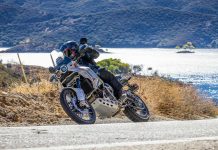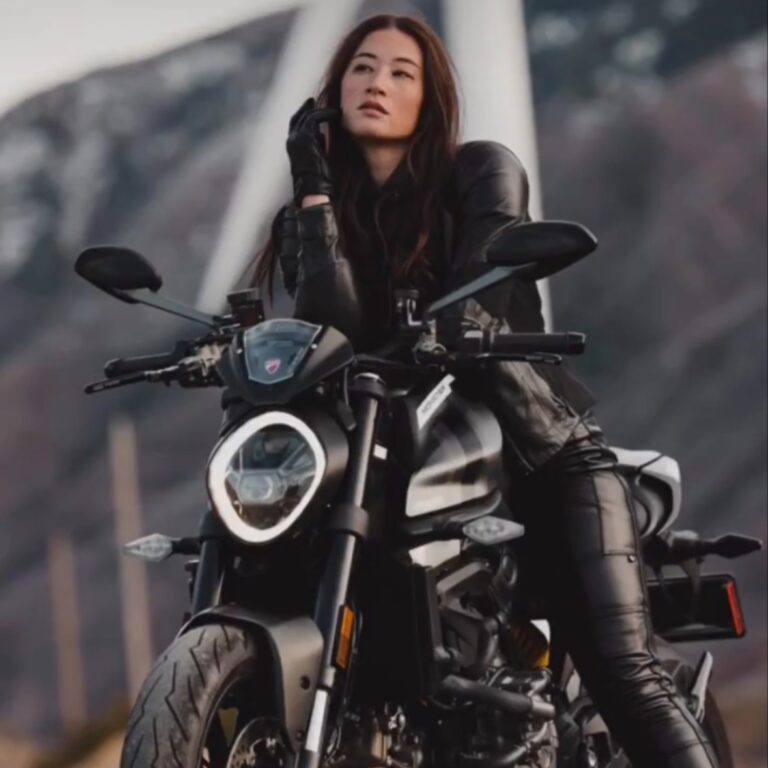Building a best-selling motorcycle must be difficult. The manufacturers try year after year, tweaking each niche market with new clever designs and features. The beauty of a dual sport motorcycle is it can be used on the street and in the dirt, though it has challenges of its own. Do you design the bike to be more street or more dirt? You can’t have both. The Europeans focus on race-ready motorcycles modified to be street-legal, while the Japanese dual-sport bikes test to be much less expensive and relatively docile. For those who want an affordable, reasonably capable, highly reliable, low-maintenance dual sport bike, there’s the Kawasaki KLX300, a dual-sport motorcycle with a starting MSRP of $6199 in 2023 (including Commodity Surcharge). However, my Kawasaki KLX300 long-term test bike was born in 2021.
What the Kawasaki KLX300 is capable of satisfying is the basic desire to get out and explore. Many enthusiasts want to get out and feel nature without feeling it in the bank account. If you demand higher performance than that, you will spend considerably more hard-earned cash.
My first experience on the KLX300 was attending a press ride in Northern California. After the initial ride, I brought it home for this extended test.

My first idea was to modify it more for additional power. I expected more from the DOHC, liquid-cooled, fuel-injected. I tried a quick fix of removing the airbox cover and its restrictive snorkel. All I got was the loud sound of it gasping for more fuel—I couldn’t hear the exhaust.
For the novice rider, it performs as expected. It’s not a monster. It doesn’t intimidate or scare. You ride it like you have nothing to prove and simply enjoy its fundamental purpose. Improving it for your personal needs is still an option—350cc big bore kits are out there, though I haven’t tried one.
Given that a dual-sport bike often ventures far from gas stations, especially in the California mountains and desert, I wanted a longer range. The KLX300’s fuel tank holds just two gallons. Even with the efficiency of fuel injection, you can run through fairly quickly. Although the KLX300’s dash has a low fuel warning, what it offers in range is a guess, and not one I want to make in the middle of nowhere.
Let me give you an example of a typical ride.
Leaving my town at the most southern point in the Sierra Nevadas at an altitude of 4200 feet, I head to my destination of Pete Brewer’s old Ponderosa Lodge—roughly 125 miles and four hours away, 7200 feet above sea level in Springfield. [Editor’s note: Since the article was written, the Ponderosa Lodge is closed indefinitely due to fire.]
My route there takes me to the lowest elevation—1300 feet—at Caliente. Caliente is a historic railroad town that’s nearly a ghost town these days. It sits a couple of miles north of California Highway 58 and was the warmest spot on my summer ride.
There’s no gas station in Caliente or Ponderosa, so I filled up at Camp Nelson at the General Store—yes, that’s what it’s called. I was taking a chance, as it was July 4. Riding down California Highway 190 to Porterville—the same Porterville made famous by Credence Clearwater Revival—was a time-consuming option. Or, I could ride down The Great Western Divide Highway and Mountain Highway 999 to Kernville, and hopefully make it. That would be the better option because it leads me back home. If I did run dry, I would have had the opportunity to try to scrounge some fuel from one of the hundreds of campsites with gas on hand to run their generators over the long holiday weekend.
I added an SAE power supply cord with a USB charging port extension directly to the battery so I could carry and charge my phone. I used a simple Ram bar mount with a SlipGrip cell phone holder for my Samsung with an Otterbox Defender case. I kept the home charger and cord at home. A full charge will last through a night if staying overnight. I left my Garmin GPS unit at home. I preferred quick access to my smartphone for photos over tracking the ride.
With a near-full tank, I headed to the Ponderosa Lodge, which had the grill in operation. I enjoyed a burger and headed for more dirt, avoiding the busy canyon drive among the water enthusiasts along the Kern River. The next fuel station would be in Lake Isabella—close enough to my home to make me confident of having enough fuel to take the more scenic dirt route. Instead of riding other favorite routes to Lake Isabella that late morning, my ride would be a long one. It ended after 265 miles, with daylight to spare.
 The Kawasaki KLX300 creates plenty of heat in the chin and leg areas on hot days, so the radiator fan kicked on a few times during my many stops. Happily, the heat wasn’t unbearable.
The Kawasaki KLX300 creates plenty of heat in the chin and leg areas on hot days, so the radiator fan kicked on a few times during my many stops. Happily, the heat wasn’t unbearable.
The original plan was hoping that the Ponderosa Lodge had an available room—without one, I’d ride back home. I would have more saddle time and a chance to write this story from my 14-inch laptop I carried in my Tourmaster Elite saddlebags while sitting over a beer at the saloon. The bags included a night’s change of clothes and toiletries. However, I couldn’t secure a room, so I was homeward-bound.
 The bags also carried snacks, water, and my trusty USFS map, which I never leave home without. Still, this was a forest I traveled throughout the 1990s, and my memory still works. I organized the AMA National Dual Sport-sanctioned ride from Lake Isabella and knew everything about the area. I still know where my favorite trails are; some aren’t on the map. Unfortunately, a large portion of Sequoia National Forest became the Giant Sequoia Monument during Pres. Clinton’s last two weeks in office. We lost all the great trails I opened, maintained, and got Green Sticker funds for signage.
The bags also carried snacks, water, and my trusty USFS map, which I never leave home without. Still, this was a forest I traveled throughout the 1990s, and my memory still works. I organized the AMA National Dual Sport-sanctioned ride from Lake Isabella and knew everything about the area. I still know where my favorite trails are; some aren’t on the map. Unfortunately, a large portion of Sequoia National Forest became the Giant Sequoia Monument during Pres. Clinton’s last two weeks in office. We lost all the great trails I opened, maintained, and got Green Sticker funds for signage.
The Kawasaki KLX300 got a taste of many different terrains this day, and almost every mile is a curvy, winding, tight two-lane (or less) USFS road. It even got a taste of challenging single-track and some 65 mph on California State Highway 58—alternately described on Google Maps as the Blue Star Memorial Highway and the Bakersfield-Barstow Highway, everyone calls it “The 58”.
 This sort of ride is what makes the Kawasaki KLX300 such a great bang for the buck. My first motorcycle showroom purchase was a 1987 Kawasaki KLR650. I rode the big KLR hard and fast to work towards that Paris-Dakar Rally participant fantasy. I did a lot of racing and raced navigational rallies whenever there was one. And here I am, 34 years later, on a KLX300.
This sort of ride is what makes the Kawasaki KLX300 such a great bang for the buck. My first motorcycle showroom purchase was a 1987 Kawasaki KLR650. I rode the big KLR hard and fast to work towards that Paris-Dakar Rally participant fantasy. I did a lot of racing and raced navigational rallies whenever there was one. And here I am, 34 years later, on a KLX300.
At 60+ years old, I am in the Attack Mode mood less frequently, so the Kawasaki KLX300 performs well. It accomplishes all the tasks I ask, and I’m in no pain, though at six feet even, I could use a taller bar and seat for more room. The KLX300 has a good aftermarket following.
 The suspension works just fine. The KLX300 arrives with a 43mm cartridge fork with 10 inches of travel, and the linkage-assisted shock controls nine inches of wheel travel. The remote reservoir shock is fully adjustable, while the fork has only compression-damping adjustments. With a 180-pound rider aboard, it’s plush. For my casual riding—no Attack Mode—I had no complaints.
The suspension works just fine. The KLX300 arrives with a 43mm cartridge fork with 10 inches of travel, and the linkage-assisted shock controls nine inches of wheel travel. The remote reservoir shock is fully adjustable, while the fork has only compression-damping adjustments. With a 180-pound rider aboard, it’s plush. For my casual riding—no Attack Mode—I had no complaints.
The clutch and brakes are quality OEM parts. The KLX300 is assembled and well-engineered at an affordable price, and has small passenger pegs. Riding two-up for a few days is no easy task on a 300 dual-sport; that’s what the KLR650 is for. However, for a day trip, go ahead and share the experience! Another favorite thing to do!
 I learned the hard way that if you don’t turn the ignition off relatively quickly, you’ll have a dead battery. Kawasaki reduced the battery size and added a spacer to the battery holder. If you’ll be traveling far off-road, install a higher-capacity battery, or bring a compact battery jump starter, such as the Weego or Fanttik T8 Apex. As is standard in the 21st century, the KLX300 has no kickstarter.
I learned the hard way that if you don’t turn the ignition off relatively quickly, you’ll have a dead battery. Kawasaki reduced the battery size and added a spacer to the battery holder. If you’ll be traveling far off-road, install a higher-capacity battery, or bring a compact battery jump starter, such as the Weego or Fanttik T8 Apex. As is standard in the 21st century, the KLX300 has no kickstarter.
The Kawasaki KLX300 reminds me of the earlier joy of just being mobile and being able to roam our beautiful country. The sights, sounds, and smells of the cattle ranches, cedar trees, and giant sequoias are just some of the reasons why I’m a motorcycle enthusiast in general, and a dual-sport diehard specifically. Except for the battery, the KLX300 never let me down in over a year of varied use. Dual-sport motorcycles have been around for 55 years, and it’s still a viable platform for exploring beyond the beaten path, as I discovered on this Kawasaki KLX300 long-term test.
Photography by Damon Powell
Kawasaki KLX300 Specs
ENGINE
- Type: Single-cylinder
- Displacement: 292cc
- Bore x stroke: 78.0 x 61.2mm
- Compression ratio: 11.1:1
- Valvetrain: DOHC; 4 valves
- Fueling: EFI w/ 34mm throttle body
- Cooling: Liquid
- Transmission: 6-speed
- Final drive: Chain
CHASSIS
- Front suspension; travel: Compression-damping adjustable 43mm inverted cartridge fork; 10.0 inches
- Rear suspension; travel: Linkage-assisted, fully adjustable piggyback-reservoir shock; 9.1 inches
- Tires: Dunlop D605
- Front tire: 3.00 x 21
- Rear tire: 4.60 x 18
- Front brake: 250mm petal disc w/ 2-piston Nissin caliper
- Rear brake: 240mm petal disc w/ single-piston caliper
- ABS: None
DIMENSIONS and CAPACITIES
- Wheelbase: 56.7 inches
- Rake: 26.7 degrees
- Trail: 4.2 inches
- Seat height: 35.2 inches
- Ground clearance: 10.8 inches
- Fuel tank capacity: 2.0 gallons
- Curb weight: 302 pounds









![2023 KTM 390 Adventure Review [15 Fast Facts] 2023 KTM 390 Adventure Review: For Sale](https://ultimatemotorcycling.com/wp-content/uploads/2023/10/2023-ktm-390-adventure-review-24-218x150.webp)
![2023 Kawasaki KLR650 S ABS Review [15 Fast Facts]](https://ultimatemotorcycling.com/wp-content/uploads/2023/10/2023-kawasaki-klr650-s-review-dual-sport-adventure-motorcycle-14-218x150.webp)
